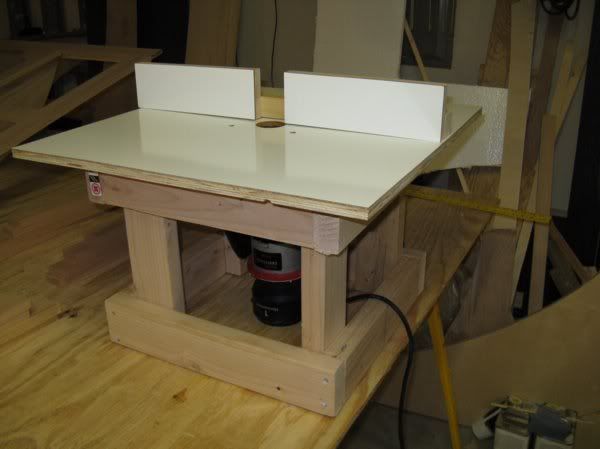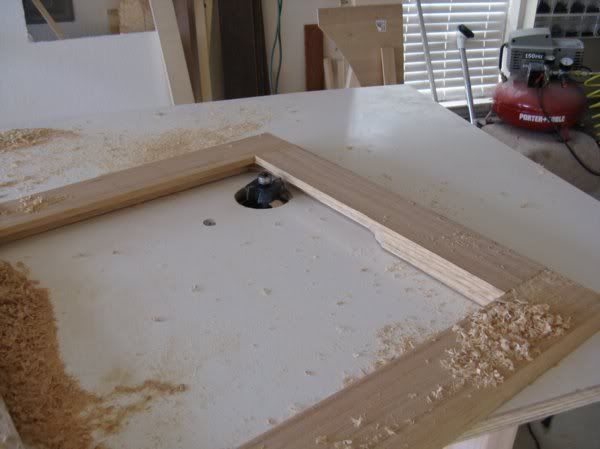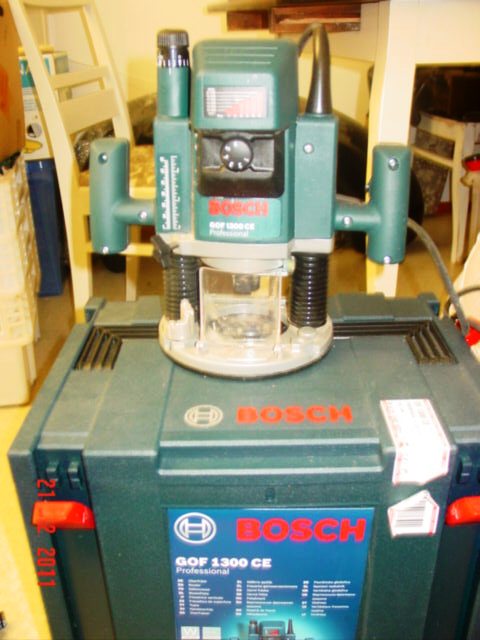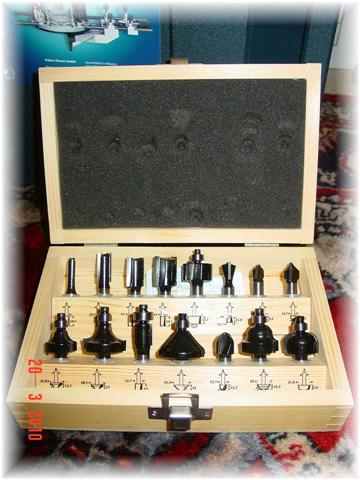Page 1 of 1
Router use question

Posted:
Mon Feb 07, 2011 11:41 amby Classic Finn
Id like to know as to how difficult is it to use the router on Oak since it is a very hard wood in the first place? I have hardly any knowledge in this so I thought best to ask


Ive cut oak on my table saw and it left black marks on the wood..I ended up sanding it off. Will the router leave same type of marks?
Do I need a special type blade?


Posted:
Mon Feb 07, 2011 1:15 pmby RN
Not too hard to cut. I would advise that you use quality router bits. I use Freud router bits and have cut some Brazilian Cherry also known as Ipe' or Iron wood with them. No problems with this wood and a 2.25 hp router.

Posted:
Mon Feb 07, 2011 1:36 pmby Rock
CF,
Oak can be a challenge. The black marks are the wood actually burning. That could be from going too slow, a blade not sharp enough, or some other issue with the tool such as poor alignment.
The router is not hard to use on oak. You will want to move the router at a fairly good speed to avoid the burning. Oak has a tendency to splinter or split out. If you have the option you should take multiple smaller cuts rather than take it all at once. Best to practice as much as you can on sample pieces before butchering your nice work piece. I'm sure you can do it based on your other work

Eric

Posted:
Mon Feb 07, 2011 1:47 pmby Dusty82
Ditto what RN said. Use a good quality Carbide tipped bit and slow down. Oak machines beautifully and takes a routed profile very well. That's one of the reasons oak picture frames are so popular among home woodworkers.
The black marks you experienced with the table saw blade generally come from heat build up and are usually the result of feeding the wood through the blade too fast, although a few other things can cause them as well. The same can happen very easily with a router if you try to rush things. Just slow down, let the tool do the work, and use sharp, good quality, carbide-tipped blades and bits. I like the Freud bits too.
If you need to rout end grain as well as long grain, rout the end grain first so that any chip-out is removed when you rout the long grain.
Something that has really helped me get a good result is to wax the router base, and keep it polished nice and slick. If you're using a router table, wax the entire tabletop. That lets the router glide over the work smoothly, without grabbing it and causing the bit to spin against the wood any longer than it has to. Just about any good quality wax will work (I use Johnson's Paste Wax) but avoid anything that contains silicone. Silicone will easily penetrate the wood fibers and makes a piece difficult to finish. Stains and topcoats will not penetrate the silicone, and you'll end up with a real mess. Stick to natural waxes on the router base and saw table, polish it like you would a car fender, and you'll be fine.
EDIT: I see Rock has posted too. Did you find that speeding up your cut eliminated the burning? I've found just the opposite. Whenever I tried a faster cut rate, I got more burning than I did when I slowed down. The same was true when running hickory or pecan.

Posted:
Mon Feb 07, 2011 1:54 pmby Classic Finn
Thank you so kindly for your replies and time to answer. I have a professional Bosch Router and it by no means is a cheap one. Wife almost wooped my buttocks for spending so much money on it.
The bits themselves also cost a mint so by no means are they any china bits or as we say ping pong bits

I just dont have too much experience with the oak. Pine is easy as is birch but oak is a bit touchy for me.
I,ll post pics for you of the routing once as you say give it a practice run before going for the actual piece or pieces.



Posted:
Mon Feb 07, 2011 2:55 pmby rbeemer
Heikki,
The burn from your table saw is probably from the the build-up of pitch or blade getting dull.
When using the router do multiple passes - If you are rounding the edges a bit with a bearing should take care of any burning. I have routed hard maple, birch and oak and have not noticed any difference when using the router. Sometimes burning will happen when you try to take a too big of cut. Do not try to go any faster than you are comfortable.
Just my thoughts,

Posted:
Mon Feb 07, 2011 3:22 pmby Classic Finn
rbeemer wrote:Heikki,
The burn from your table saw is probably from the the build-up of pitch or blade getting dull.
When using the router do multiple passes - If you are rounding the edges a bit with a bearing should take care of any burning. I have routed hard maple, birch and oak and have not noticed any difference when using the router. Sometimes burning will happen when you try to take a too big of cut. Do not try to go any faster than you are comfortable.
Just my thoughts,
Thank You Rick I shall remember what is said here.

By the way the table saw is new as well as the blade.

alignment maybe?

Posted:
Mon Feb 07, 2011 3:28 pmby Rock
I use mostly cherry which burns very easy. I've gotten kind of gun shy that way. I've you're not moving along it's burning.
And yes pushing oak too hard will give other problems. Usually my burning issues on oak were from dull tools or the table saw fence out of alignment.
Eric

Posted:
Mon Feb 07, 2011 3:29 pmby planovet
All my cabinets are Red Oak and I used a router on all of them. Go steady and you should be fine. If you bog down, that's when you tend to get the black marks. They will usually sand out though!
I built a homemade router table to help with the thinner pieces. It made a world of difference.



Posted:
Mon Feb 07, 2011 3:33 pmby aggie79
Heikki,
As the others have said, on both using the table saw and router, the keys are use high quality bits/blades (carbide) and speed. Too slow can be as bad as too fast.
Regarding the table saw, I would most definitely align the saw. I use a machined aluminum plate in place of the blade and align the blade parallel to the guides for the miter gauge using a special jig that has a dial caliper. Then I align the fence to the guides.
If you are not already doing so, you may want to consider a thin kerf blade and blade stabilizer.
(BTW, is Kimi going to replace Kubica at Lotus Renault?)
Take care,
Tom

Posted:
Mon Feb 07, 2011 5:26 pmby rbeemer
Classic Finn wrote:By the way the table saw is new as well as the blade.

alignment maybe?
Burning usually happens on the out-feed side of the cut(past the middle of the blade)
Sounds like it is alignment, I would check the fence first and the easy way is to put front of the fence along the mitre slot, lock it down and see if stays along the edge of the slot. If not adjust accordingly, check the user's guide but I have my fence follow the slot instead of slightly(3mm) away from the blade at the out-feed of the table. If you are using a splitter make sure it is also setup correctly, if you are not using a splitter, it is a good time to get one installed(they make after-market kits.
Hope this helps

Posted:
Sun Feb 20, 2011 12:33 pmby Classic Finn
planovet wrote:All my cabinets are Red Oak and I used a router on all of them. Go steady and you should be fine. If you bog down, that's when you tend to get the black marks. They will usually sand out though!
I built a homemade router table to help with the thinner pieces. It made a world of difference.


Mark what does the router bit look like which you used on your work?
I,ll show pics of the bits I have shortly


Posted:
Sun Feb 20, 2011 1:38 pmby Ageless
The 'burning' on oak is due to the content of tannic acid in the wood. A slower feed and less depth of cut reduces the build-up of heat.

Posted:
Sun Feb 20, 2011 4:20 pmby kennyrayandersen
Ageless wrote:The 'burning' on oak is due to the content of tannic acid in the wood. A slower feed and less depth of cut reduces the build-up of heat.
I've had more trouble with the burning if the saw blade is out of alignment, or the tool (blade or bit) is dull, However, I would argee that multiple passes taking smaller cut seems to help with oak -- especially as it does tend to tear out with deeper cuts. I seem to have better luck with white oak.

Posted:
Sun Feb 20, 2011 6:18 pmby Classic Finn
Here,s our Bosch Router and the Bosch Bits we have.











 alignment maybe?
alignment maybe?
